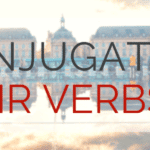
The French passé simple (sometimes called the past historic) is a special type of French past tense that’s used in formal rather than conversational French. It’s mostly used in contexts like academic writing, literature, and in formal speeches to speak about past events that have no particular relevance to the present (from the speaker’s or writer’s point of view).
How to Recognize the Passé Simple
You’re probably not going to have to from passé simple on your own very often, unless you want to learn advanced French and expect to be communicating in one of the circumstances above.
However, you need to be able to recognize it, because you’ll run into it in written French fairly often. And recognizing the root verbs isn’t always easy, because certain conjugations of common verbs look nothing like their roots.
As you’ll see below, this is a “simple” verb tense (meaning it’s conjugated with one verb instead of two parts, with an auxiliary verb). There are also a lot of circumflexes (â, î, and û) in verbs in the passé simple. If you ever see a nous or a vous followed by a verb you don’t recognize that has a circumflex in it, it’s probably in passé simple.
Common Irregular Passé Simple Verbs
We’ll start with the passé simple conjugations of the four most common verbs: avoir, être, aller, and faire (the same four verbs that have irregular conjugations in so many French tenses).
The core four passé simple conjugations
| être | |
| je fus | nous fûmes |
| tu fus | vous fûtes |
| il fut | ils furent |
| avoir | |
| j’eus | nous eûmes |
| tu eus | vous eûtes |
| il eut | ils eurent |
| aller | |
| j’allai | nous allâmes |
| tu allas | vous allâtes |
| il alla | ils allèrent |
| faire | |
| je fis | nous fîmes |
| tu fis | vous fîtes |
| il fit | ils firent |
Être vs faire
Note how similar the être and faire conjugations are in passé simple (and how neither of them looks much like their root verb). Être has the fu– stem, and faire has the fi– stem.
Aller
We’ve included aller in the conjugation tables above to just to show all four of the common verbs in the same place, but it isn’t actually irregular in the passé simple. Aller follows the same pattern, shown below, that regular -er verbs do.
Passé Simple Conjugation Patterns
Most verbs follow predictable conjugations patterns in the passé simple. The conjugations will usually look relatively normal on the singular side (the je, tu, and il/elle conjugations). The plural side is where things get a little odd-looking.
Regular -er verbs in the passé simple
For regular -er verbs, drop the -er ending and add the following endings. We’ll use danser as an example.
| danser (“to dance”) | |
| je dansai | nous dansâmes |
| tu dansas | vous dansâtes |
| il dansa | ils dansèrent |
For example:
Pendant une décennie, elle dansa pour le ballet de Chicago. (“For a decade she danced for the Chicago ballet.”)
Notice the verb endings on the singular side match the singular conjugations for avoir in the present tense (j’ai, tu as, il a), which should make the pattern a little easier to remember.
Regular –ir and -re verbs in the passé simple
For both -ir and -re verbs , drop the ending and add the following endings. For -ir verbs, we’ll use choisir as an example.
| choisir (“to choose) | |
| je choisis | nous choisîmes |
| tu choisis | vous choisîtes |
| il choisit | ils choisirent |
For example:
Ils choisirent de désobéir à l’ordre du roi. (“They chose to disobey the king’s order.”)
Notice that for regular -ir verbs, the singular side looks exactly like their singular conjugations in the present tense, which means three fewer new verb conjugations for you to learn.
For –re verbs, we’ll use vendre as an example.
| vendre (“to sell”) | |
| je vendis | nous vendîmes |
| tu vendis | vous vendîtes |
| il vendit | ils vendirent |
For example:
La ville vendit le bâtiment il y a soixante ans. (“The city sold the building sixty years ago.”)
Vendre and other regular -re verbs follow the same pattern as regular -ir verb conjugations.
Irregular Verbs in the passé simple
Finally, some other common verbs have irregular passé simple forms. These verbs fall into two main categories.
Irregular verb stems, but regular ir/re verb endings
Many verbs have irregular verb stems, but the endings themselves are the usual passé simple -ir/-re endings. These include:
| Verb | Passé simple root |
| écrire | écriv– |
| prendre | pr- |
| dire | d– |
| voir | v– |
| mettre | m– |
| venir | vin- (but do not add extra i’s, so that the plural side becomes nous vînmes, vous vîntes, and ils vinrent)) |
Irregular verb stems using u‘s instead of i‘s
These verb stems use u‘s and come from the past participle forms of these verbs. When you conjugate them, you will not use the i in the -is, -is, -it, -îmes, -îtes and –irent verb endings but instead replace that vowel with a u.
| Verb | Passé simple root |
| boire | bu- (je bus, tu bus, il but, nous bûmes, vous bûtes, ils burent) |
| devoir | du- (je dus, tu dus, il dut, nous dûmes, vous dûtes, ils durent) |
| lire | lu– (je lus, tu lus, il lut, nous lûmes, vous lûtes, ils lurent) |
| savoir | su– (je sus, tu sus, il sut, nous sûmes, vous sûtes, ils surent) |
| vouloir | voulu- (je voulus, tu voulus, il voulut, nous voulûmes, vous voulûtes, ils voulurent) |
And those are all the basics of understanding and conjugating the French passé simple!
Next Steps
Now you should know the most common verbs you’re likely to see in passé simple and how to conjugate the most common verbs. If you ever have to form this tense on your own, you can always check your conjugations with one of many tools online. For the past tenses you’re much more likely to use, make sure you understand the passé composé, imparfait, and plus-que parfait. If you’ve mastered these, check out our past subjunctive lesson.



